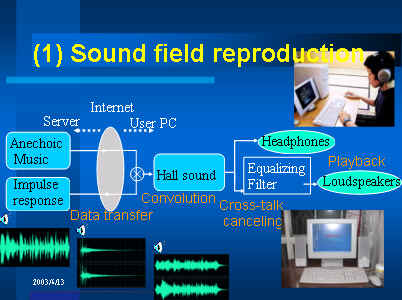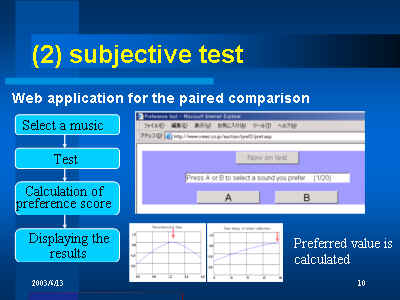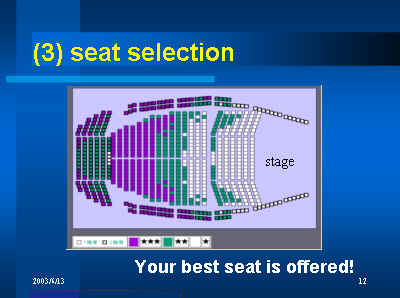
First proposal for the project funded by TAO (Telecommunications Advancement Organization of Japan) in 2002
Background
Generally, the criterion of selecting a seat in a concert hall is a good stage view. The ticket price becomes expensive for the seats close to the stage. It is not widely recognized, however, that the sound quality changes a lot by the position inside the hall. Also, it has been found that there is the individual difference in the preference of the sound qualities, such as sound volume and reverberance, and the preference is influenced by the kind of music performed. We think that the audiences can obtain higher satisfaction if they know their preference of sound and listen to the music at their suitable seats. What we propose in this project is the system by which the audience can choose the seat in the concert hall based on their preference and can purchase a ticket on line.
Goal of the project
We aim at the development of the following three items in the project.
High quality sound field reproduction on the Internet
It is important to give audiences the chance of experiencing the sound of
concert halls before they know what sound they prefer. The equipment which can
carry out the virtual sound experience of a music hall is called the
Auralization system, and attracts attention as the state-of-the-art technology
in room acoustics. But previously, it required expensive equipment at the
laboratory level. We aim at reproducing the concert hall sound field on the
Internet by using the consumer-level audio equipment.

Subjective preference test system
We use Ando's preference theory as a method to evaluate audience's sound
preference. Evaluation indices are 1) sound level, 2) reverberation time, 3)
initial time delay gap, and 4) inter-aural cross-correlation. Those parameters
have been found to affect the subjective preference of sound field
independently. Subjects are asked to listen to the pairs of music pieces with
controlled sound effects and to judge which one they prefer. We construct the
Web based application for this subjective test. Measured values of those
parameters in the actual hall or the calculated values by the computer
simulation based on the image method are used to control the sound motif.

Seat selection and online ticket sales
After the subjective test, the rank of each seat is calculated by comparing the
users' preferred values and the seat's measured values of four acoustic
parameters. Results are shown as a seating map with different colors depending
on their "matching score". Users can make reservations for the seat
after they confirm what sound is heard at that seat.

Work plan
Sound field reproduction on the Internet (Collaboration with Prof.
Ando)
To reproduce the sound field of concert halls, the above mentioned acoustic
parameters are controlled. Measured values in the actual halls or the calculated
values by the computer simulation are used. Sound fields can be reproduced by
adding the reflections with appropriate time delay and amplitude, or by
convolving the binaural impulse responses with the sound source. To make the
quality of reproduced sound field not to be affected by user's sound
reproduction equipment, we try to develop the reproduction method using the
consumer level equipments.
Seat selection based on the preference test (Collaboration with Prof.
Ando)
We develop the Web application by which the sample music is replayed, the
subjective test is performed, the preference score of the seats is calculated,
and the seating map is displayed. We examine the validity of the subjective test
on the Web by comparing it with the results performed in the laboratory.
Online ticket sales
We construct the online ticket sales system which is linked with the seat
selection system. The validity of the system is tested in several concert halls
in Japan.
Reference
Ando, Y. (1985). Concert hall acoustics, Springer-Verlag, New York.
Ando, Y. (1998). Architectural acoustics -Blending Sound Sources, Sound Fields, and Listeners-, AIP Press/Springer-Verlag, New York.